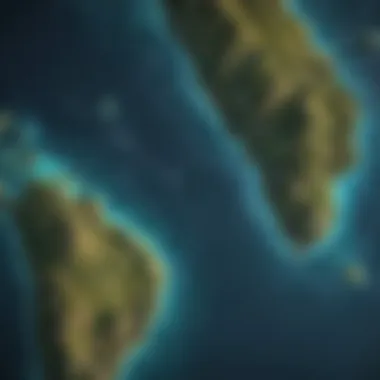Understanding the Richness of Micronesian Languages


Research Context
Background and Rationale
Micronesian languages hold an essential place in the tapestry of the world's linguistic heritage. These languages, spoken across various islands and atolls in the Central Pacific, showcase not only unique grammatical structures but also deep ties to the cultures and histories of their speakers. Given the increasing challenges posed by globalization and cultural homogenization, there is a pressing need to explore and document these languages. Understanding their evolution and significance helps preserve not just the languages themselves, but also the identities and traditions tied to them.
Micronesia, encompassing thousands of islands, is home to several language families, including the Oceanic and the various Western and Eastern Malayo-Polynesian languages. Each of these families possesses distinct features that reflect the diversity of their environments and cultures. By examining these languages, researchers can unlock insights into the intricate social structures, traditions, and worldviews of the Micronesian peoples.
Literature Review
While many studies have explored the grammar and phonology of individual Micronesian languages, an integrated approach that encompasses the broader socio-historical contexts is still lacking. Several key works have laid the groundwork for understanding these languages and their cultural contexts. For example, in Languages of Micronesia by William A. Foley, the author articulates the linguistic diversity and the social implications tied to language use in the region. Further research by linguists like Andrew Pawley and Francesca Merlan delves into specific languages, highlighting their unique structures and vocabularies.
Nevertheless, much work remains to be done to encompass the full spectrum of Micronesian languages. Analysts must look at how languages like Chamorro, Palauan, and Pohnpeian have evolved, merged, and sometimes even faded away, often influenced by external pressures. Scholars such as Rubén M. Valerio and Mary L. Tiemann discuss the delicate balance between language preservation and the rapid shifts brought about by modernity and globalization, calling for dedicated efforts to document these languages before they lose their speakers entirely.
Methodology
Research Design
This study employs a mixed-methods approach to explore the dynamics of Micronesian languages. By combining qualitative interviews with quantitative data analysis, the research aims to provide a holistic understanding of language use and preservation efforts. Interviewing native speakers and community leaders will offer a lens into the lived experiences and attitudes towards language maintenance and shift.
Data Collection Methods
Data collection will be conducted through:
- Field Interviews: Engaging with local communities to gather firsthand accounts will create a rich tapestry of cultural context.
- Surveys: Gathering demographic data on language speakers, usage patterns, and attitudes towards language learning and preservation.
- Archival Research: Investigating historical documents and linguistic records will help trace language evolution and the impact of external influences in the region.
A comprehensive analysis of these data sources will ultimately contribute to a nuanced understanding of Micronesian languages, emphasizing their significance, evolution, and current challenges.
Prelude to Micronesian Languages
Micronesian languages hold a special place in the tapestry of global linguistic diversity. This article invites readers to ponder not just the languages themselves but the cultures, histories, and identities they embody. With over a thousand islands scattered across the Pacific, the significance of these languages goes beyond mere communication; they encapsulate the essence of community, heritage, and survival.
Overview of Micronesia
Micronesia, a region steeped in rich cultural history, is composed of several significant groups of islands, including the Federated States of Micronesia, Palau, the Marshall Islands, and others. Each island, although sometimes classified under one umbrella, presents a unique cultural and linguistic identity. Once upon a time, these islands were home to thriving societies, each with their own intricate systems of governance, traditions, and spirituality. Today, many islanders still hold onto these rich traditions, relying on their languages not just for daily communication but as a vessel for their ancestral wisdom.
For scholars, the geographical expanse of Micronesia serves as an extraordinary living laboratory. The interplay between languages is frequently influenced by trade, migration, and interactions among island groups, which is a reflection of the adaptability and resilience of these communities. Understanding the nuances of these languages aids in grasping the larger oceanic narrative.
Defining Language Families
To make sense of Micronesian languages, we must first recognize their linguistic affiliations. They can be broadly categorized into several language families, primarily Eastern and Western Micronesian languages. These families highlight not only commonalities among the languages but also the diverse pathways through which they’ve evolved.
The distinctions among the languages are not merely academic; they are crucial for linguistic preservation and revitalization efforts. Knowing which language belongs to which family is vital in language teaching, documentation, and community empowerment initiatives.
It's worth noting, according to linguistic studies, that certain words may hold similar meanings, yet their pronunciations might diverge significantly, making it essential to consult resources such as Wikipedia for further exploration. Additionally, some languages show strong influences from colonial history, which can lead to linguistic borrowing and code-switching practices that intertwine the old with the new.
"Language is not just a tool for communication but a repository of history and identity."
Epilogue
In summary, the analysis of Micronesian languages is not simply an academic pursuit. It fosters a deeper respect for the richness of cultures and the significance of languages in bridging communities. As we delve deeper into this exploration, we build a foundation for understanding the intricate relationships among linguistic identity, culture, and history.
Geographical Distribution of Micronesian Languages
Understanding the geographical distribution of languages is essential for grasping the cultural and historical contexts that define them. This aspect of Micronesian languages reveals much more than where they are spoken; it unfolds a tapestry of migrations, trade, and social interactions among the islands. The way languages morph and intermingle in different locales provides insight into the shared experiences and adaptations of communities. In this section, we will navigate through the main islands and their associated language variants, as well as the patterns of language distribution that have evolved over time.
Main Islands and Language Variants
Micronesia encompasses hundreds of islands, grouped into several distinct regions. Each locale brings its distinct dialects and languages, influenced by factors such as geography and historical contact with different cultures. For example, in the Federated States of Micronesia, we find several major islands such as Pohnpei, Kosrae, Chuuk, and Yap. Each of these islands hosts its own language variant:
- Pohnpeian is spoken in Pohnpei and distinguishes itself through unique phonetics and vocabulary.
- Kosraean is found in Kosrae, showcasing specific grammatical features not present in other languages.
- Chuukese, prominent in Chuuk, is known for its complex system of pronouns and verb forms.
- Yapese, the language on Yap, reflects local culture through terms related to their traditional practices.
Similarly, the Mariana Islands, which include Guam and the Northern Mariana Islands, predominantly speak Chamorro. This language is heavily influenced by Spanish due to historical colonization, while Carolinian is primarily spoken in the Northern islands, creating a fascinating blend of linguistic heritage.
Moreover, the Marshall Islands features Marshallese, recognized for its unique sounds and a vast range of dialectal variations across different atolls. Each island's linguistic identity is not merely a product of phonetics but is steeped in the culture, history, and social fabric that bind its people.
Language Distribution Patterns
Language distribution in Micronesia does not follow a rigid pattern; rather, it reflects the dynamic nature of human interaction across the islands. Contact between neighboring islands has led to significant borrowing of vocabulary and syntactic structures.
Two primary factors influence these patterns:


- Geographical Barriers: The vast oceanic expanse creates natural divides. While some languages share similarities due to close geographical proximity, others diverge sharply because the islands are too far apart for regular interaction.
- Migration and Settlement: Historical migrations have left their imprints on language. Some islands, like Palau and Nauru, are linguistically distinct but closely connected culturally through trade routes that once facilitated the exchange of goods and ideas. For example, the northern islands exhibit features that align them more closely with the Austronesian family, while southern islands retain some Polynesian characteristics.
The intermingling is more than purely linguistic; it often signifies shared histories. As communities adapted to external influences, the languages grew richer and more diverse.
In summary, the geographical layout and movement of people across this vast region play a crucial role in shaping Micronesian languages. Such an understanding allows us to appreciate not only the complexity of these languages but also the cultural narratives embedded within them.
"Languages are not just tools for communication; they are vessels carrying the weight of history and identity."
The deep-seated connections between language and place remind us that each variant is a living story, narrating the experiences of its speakers through generations. As we proceed, these insights will serve as a foundation to explore other vital aspects of Micronesian languages.
Key Language Families
Language families are like the family tree of words and communication. They help us understand how different languages are connected and how they evolve over time. In the context of Micronesian languages, exploring these families reveals much about the cultures, histories, and influences that shaped the people of the region. Each language family reflects unique sociolinguistic dynamics, offering insights into the cultural identifiers and the everyday lives of Micronesians. Identifying these key language families enables a clearer understanding of the area’s rich linguistic diversity and the broader narrative of human communication.
Eastern Micronesian Languages
Eastern Micronesian languages encompass a variety of tongues, most notably including Gilbertese, Nauruan, and Kosraean. These languages are predominantly spoken in the eastern islands of Micronesia, where the Pacific Ocean greatly influences both lifestyle and communication.
The phonological characteristics of Eastern Micronesian languages are fascinating yet complex. For instance, Gilbertese has a notable feature of vowel harmony, where the vowels in a word must match in certain characteristics. This adds a layer of intricacy to the language, reflecting not just communication but also cultural values ingrained in communal identity.
A unique syntax structure exists here with a tendency towards islands of thought. This means sentences can feel fragmented but carry rich meanings culturally. Language here serves as both a tool for everyday dialogue and a vehicle for storytelling, maintaining a deep sense of heritage.
Understanding these languages can offer insight into:
- The ecological interactions within island communities.
- The preservation of oral histories amidst changing dynamics.
- The interplay of migration patterns across the Pacific.
Western Micronesian Languages
Conversely, Western Micronesian languages like Chamorros, Palauan, and Carolinian make their mark distinctly in the western islands. These languages reveal different structural patterns and offer a glimpse into the historical migration routes of their speakers.
What stands out in Western Micronesian languages is the strong presence of loanwords from Spanish and English, showig historical influence due to colonization and outside interactions. Language adapts to context; thus, the incorporation of foreign terms blends traditional vocabulary with contemporary relevance. This showcases resilience as these communities navigate their cultural identity against external influences.
Thus, examining Western Micronesian languages sheds light on numerous aspects, such as:
- The dynamics of cultural exchange and integration.
- Language evolution as a reflection of societal change.
- The commitment to preserving indigenous dialects amidst globalization.
Role of the Carolinian Language
The Carolinian language, a member of the Western Micronesian family, plays a crucial role in maintaining the cultural identity of the Carolinian people. It features a blend of traditional elements with influences from other languages within the region. Speaking Carolinian is not just a means of communication but a profound expression of cultural heritage.
Interestingly, the Carolinian language showcases some unique morphological traits, such as the use of prefixes and suffixes that modify root words extensively. This allows for rich qualitative expressions in daily dialogues and cultural storytelling, which are essential for passing on traditions to younger generations.
Significantly, the Carolinian language contributes to:
- The preservation of ancestral knowledge within its expressions.
- Strengthening community cohesion through shared language.
- Facilitating international understanding of Micronesian issues through bilingual speakers.
"Languages reflect the soul of a culture; thus, preserving them means keeping the heart of a community alive."
In summary, each key language family serves as a lens through which the complexities of Micronesian societies can be seen. These languages are fundamental to understanding not just linguistics, but also cultural resilience, identity, and the ongoing narrative of humanity in the Pacific.
Structural Features of Micronesian Languages
Understanding the structural features of Micronesian languages is vital for grasping the linguistic richness and diversity of this region. The unique characteristics such as phonology, morphology, and syntax not only distinguish these languages from each other but also reflect their cultural contexts. Each element plays a crucial role in how speakers communicate, express identity, and maintain traditions. The examination of these traits offers insight into the broader socio-linguistic landscape, revealing how languages adapt and evolve in response to external factors like globalization and cultural shift.
Phonological Systems
The phonological systems of Micronesian languages exhibit distinct patterns and sounds that are fundamental to their identity and comprehension. Each language has its unique inventory of phonemes— the smallest units of sound that differentiate meaning. For instance, in the Chuukese language, a rich vowel system combining both long and short forms creates subtle meaning changes. This phonological variety is often influenced by geographical factors and social interaction among islands.
"Phonology shapes the way a language sounds, and in Micronesian languages, this is intricately tied to local culture and traditions."
Phonological rules may dictate how words are formed, how stress is placed, and even how certain consonants can change depending on their placement in a word. In contrast, the phonetics of the highly introversion Kosraean language utilizes fewer consonant clusters, simplifying the articulation process. This phonological diversity illustrates not only linguistic features but also aspects related to identity among speakers.
Morphological Characteristics
Morphological characteristics denote how words are structured within Micronesian languages and can greatly affect meaning. These languages predominantly use agglutination, a process where prefixes and suffixes are added to root words to modify meaning or convey tense, number, or case. Take the Pohnpeian language, where adding a suffix can indicate pluralization or verb tense with high precision. This morphological system enables speakers to construct complex ideas using minimal roots, showcasing both efficiency and expressiveness.
Additionally, many Micronesian languages rely on reduplication, a linguistic phenomenon where part of a word is repeated to modify meaning. In Chamorro, for example, reduplication can express habitual actions—exemplifying how even phonetic features play a role in semantic nuance. The ability to manipulate morphology in ways native speakers intuitively understand demonstrates the sophistication embedded within these languages.
Syntax and Sentence Structure
The syntax and sentence structure within Micronesian languages reveal unique grammatical frameworks that often reflect the speaker’s worldview and cultural practices. Generally, these languages favor Subject-Verb-Object (SVO) constructions, but this is not universally applicable. Particularly in the Yapese language, variations in sentence structure might appear based on social context, where the order of subjects and verbs can shift to emphasize different aspects of a conversation.


Moreover, the usage of pronouns and verb forms can shift according to factors such as politeness or formality. This syntactical flexibility enables speakers to convey subtle social cues through language, which is critical in tight-knit community interactions.
In summary, the structural features of Micronesian languages encapsulate a blend of cultural identity, complexity, and adaptability. A deep dive into phonology, morphology, and syntax articulates the essence of these languages, illuminating their distinctiveness while providing context for their use in both ceremonial and everyday practices.
Cultural Context and Language Use
Understanding the cultural context and language use in Micronesian societies is paramount for grasping the full significance of these languages. Language plays a central role in shaping identity and cultural practices. It is through language that traditions are conveyed and social norms established. In Micronesian communities, language serves not just as a means of communication but also as a crucial element of cultural heritage. This dual role transforms languages into living entities that reflect the history, values, and worldviews of the people who speak them.
Through daily interaction and ceremonial activities, the use of language becomes intertwined with the social fabric of Micronesian life. Different languages and dialects often carry unique connotations and cultural meanings tied to specific groups and places. Thus, understanding these languages in their cultural context enriches our comprehension of their diversity and complexity.
Language as a Cultural Identifier
In the Micronesian region, language stands as a robust marker of cultural identity. Each language, whether it be Chamorro from Guam, Carolinian from the Northern Mariana Islands, or Pohnpeian from Pohnpei, encapsulates distinct historical experiences and cultural narratives. The languages help shape group identity, distinguishing between not just different islanders but also various clans and communities within islands.
Key aspects of language as a cultural identifier include:
- Preservation of History: Languages carry stories of ancestors, migrations, and significant events that are central to the peoples' identities.
- Social Cohesion: Language fosters a sense of belonging among community members, creating bonds through shared dialects and expressions.
- Cultural Transmission: Through language, traditional practices, beliefs, and values are passed down through generations, ensuring continuity in cultural heritage.
Languages are thus not merely tools of communication but vital connections to the past and present identities of Micronesian peoples.
Ceremonial and Everyday Language Functions
Navigating through the diverse functions of language within Micronesian cultures reveals the layers of meaning embedded in both ceremonial and everyday contexts. In ceremonial settings, specific languages or styles may be employed that carry particular significance. Rituals often demand exact phrasing, intonation, or traditional idioms that enhance the gravity of the event and signify respect for cultural practices.
On the other hand, everyday language use reflects a blend of practicality and cultural nuance. Examples include:
- Nomenclature in Daily Life: The words used for local flora, fauna, and food often convey intrinsic knowledge of environment and sustainability, linking language to lifestyle.
- Expressions and Take on Humor: Local idioms and colloquial expressions are inherent to communication, giving life to conversations and allowing for cultural expression through humor and storytelling.
In summary, the cultural context and language use in Micronesian societies underscore the importance of linguistic diversity as a foundational pillar of identity and tradition. Each language plays its part in significant moments of life, from celebrations to day-to-day exchanges, highlighting the intertwining of culture, communication, and community.
Challenges Facing Micronesian Languages
The topic of challenges facing Micronesian languages is paramount in understanding the current landscape of linguistic diversity in the region. As globalization advances, it poses both threats and opportunities for these languages. This section delves into the pressing issues that these languages are grappling with in a rapidly changing world, highlighting their fragility and the necessity of revitalization efforts.
Impact of Globalization
Globalization is like a double-edged sword for Micronesian languages. On one side, it opens up new avenues for communication and access to resources, while on the other, it ruthlessly marginalizes local tongues. The influence of dominant languages, particularly English, has permeated every nook and cranny of daily life, pushing native languages further into the shadows. This trend isn’t merely about the loss of vocabulary or grammar; it's about the erosion of identity and cultural heritage.
The youth, heavily influenced by global media and technology, often prefer to communicate in a widely spoken language, resulting in language shift. Furthermore, traditional practices tied to language use are slowly waning, with communities frequently opting for a more globalized form of interaction.
To illustrate, many young people in Micronesia gravitate towards English in their social interactions, especially in urban settings. This shift is not limited to casual conversations; it extends to academic environments and professional scenarios where English is often considered the gold standard. As a result, traditional languages risk becoming mere relics of the past if this trend continues unchecked.
Language Endangerment and Revitalization Efforts
Language endangerment in Micronesia has reached alarming levels, with several languages on the brink of extinction. According to the United Nations Educational, Scientific and Cultural Organization (UNESCO), a significant number of these languages are spoken by only a few hundred individuals. The situation is dire, and immediate action is imperative.
However, amid this grim narrative, there are rays of hope. Various revitalization efforts have emerged, aimed at breathing life back into these slumbering languages.
Here are some key efforts:
- Community Language Programs: Local initiatives, often led by indigenous speakers, aim to teach younger generations their native languages through music, dance, and storytelling, embedding culture in learning.
- Integration into Educational Curriculum: Schools in some regions have started to include local languages in their teaching methods. This not only encourages the use of native tongues but also boosts self-esteem among students who feel a connection to their heritage.
- Online Resources and Social Media: Digital platforms are being leveraged to create engaging content in native languages. These resources can be accessed globally, widening the audience and facilitating language learning in innovative ways.
"When we lose a language, we lose a whole world of knowledge and culture embedded in it."
These revitalization efforts hold the promise of returning the spotlight to Micronesian languages, though maintaining momentum will require concerted community and governmental support. Understanding both the challenges and the solutions presents a comprehensive view of the future landscape of Micronesian languages.
Language Preservation Initiatives
Preserving the languages of Micronesia is like attempting to hold onto sand as it slips through one’s fingers. The importance of language preservation cannot be overstated, especially when it comes to Micronesian languages, which carry with them the essence of the local culture, values, and history. When we discuss language preservation initiatives, we move beyond mere lexicons and gramatical structures; we tap into identity, heritage, and a connection to the past that fuels community pride and cohesion.
One of the key elements of language preservation initiatives is their role in education. Educational programs dedicated to teaching Micronesian languages play a crucial part in reversing the tide of language loss, notably in younger generations. Institutions are beginning to realize that embedding local languages into school curricula helps not only in language acquisition but also in fostering cultural appreciation and understanding amongst students. Additionally, when children learn in their native tongue, it can significantly enhance their cognitive abilities, laying a strong foundation for further academic success.
“Languages are not just means of communication; they are the memory of a culture.”
Educational Programs and Language Acquisition
The crux of educational programs focused on Micronesian languages rests on integrating these languages into the formal school systems. The Ministry of Education in various Micronesian states is championing the cause, providing resources and training for teachers. Language immersion programs have been implemented in many areas, offering a chance for students to learn their native language from an early age.
Moreover, these programs can come in various forms:
- Bilingual Education: Instruction is provided in both the local language and English, making students bilingual, which can be a significant asset in today's globalized world.
- After-School Programs: Initiatives that reinforce language learning outside of traditional classrooms, perhaps through storytelling or cultural events, also enhance engagement and retention.
- Online Learning: With technology changing the landscape of education, online platforms can provide resources for language learning accessible even in remote areas.


Community Involvement in Preservation
Community involvement is the yeast that makes the dough rise in efforts to preserve Micronesian languages. When local communities actively participate in language preservation, the likelihood of success is greatly increased. Communities often have immense knowledge and understanding of their language’s nuances that formal institutions might overlook.
Several effective strategies have been observed:
- Community Workshops: Regular workshops offer a space for elders to teach younger generations about the language, customs, and oral traditions, ensuring that the roots of their heritage are not lost.
- Festivals and Cultural Events: Celebrating traditional festivals that incorporate language, song, and dance creates an engaging environment for language use while promoting community bonding.
- Local Media: The production of radio shows, podcasts, and written content in native languages encourages everyday use of the language among community members.
Engaging communities in language preservation also establishes a sense of ownership. When local individuals perceive their languages as valuable and vital to their identity, they're more likely to invest effort into keeping them alive.
Role of Technology in Language Documentation
Language documentation is becoming increasingly essential in the context of Micronesian languages. With diverse linguistic heritage comes the pressing need to preserve these languages for future generations. Technology plays a pivotal role in this process. It enhances accessibility, promotes linguistic research, and facilitates the transmission of knowledge. As Micronesian languages face endangerment from globalization and cultural shift, leveraging technology represents a crucial avenue for keeping these languages alive.
Digital Archives and Databases
Digital archives and databases offer robust platforms for storing and sharing language resources. They act as a repository for a wide range of materials, including audio recordings, written texts, and grammatical descriptions. Such digitization is not just a modern convenience; it is a lifeline. With proper documentation, researchers, students, and community members can easily access linguistic materials.
Some noteworthy contributions of digital databases include:
- Preservation: Digital formats can last longer than physical ones, reducing the risk of deterioration over time.
- Accessibility: People around the world can access documentation, enabling cross-cultural collaboration.
- Research Facilitation: Academics can analyze language data without needing to be physically present in Micronesia.
- Community Empowerment: Local communities can curate their linguistic data, ensuring they have control over how their language is represented.
"Digital archives are more than repositories; they are bridges connecting generations."
Databases that compile Micronesian languages, such as the Endangered Languages Archive, highlight the importance of community involvement in language documentation. The digitization of oral stories, rituals, and conversational forms enriches our understanding and appreciation for these languages.
Mobile Applications for Learning
Mobile apps are transforming language learning by making it more interactive and engaging. These tools offer various functionalities that cater to different learning styles. Users can practice vocabulary, pronunciation, and grammar at their convenience. Moreover, by utilizing multimedia elements such as audio and video, these apps create a dynamic learning environment that traditional methods may lack.
Features often found in these applications include:
- Gamification: Incorporating games can make learning fun and more effective.
- Cultural Context: Integrating cultural lessons provides learners with a deeper understanding of the language.
- Offline Access: Many apps allow for downloading content, enabling users to learn without a stable internet connection.
The significance of mobile applications extends beyond individual learning. They also support educators by providing supplementary resources to teach Micronesian languages effectively. Encouraging community-driven content creation empowers locals to take pride in their linguistic heritage. As more people engage with these languages digitally, the chances of revitalization can notably improve.
Prospects for the Future of Micronesian Languages
The future prospects of Micronesian languages hinge on a myriad of factors that blend cultural preservation and modernity. As the world becomes more interconnected, languages face the double-edged sword of globalization, which presents both opportunities and challenges. Understanding these prospects is crucial, not just for linguists and researchers, but for communities looking to retain their cultural identity. Micronesian languages hold a wealth of knowledge, historical significance, and cultural heritage that, if nurtured, can thrive alongside global languages.
Potential for Language Revival
The revival of Micronesian languages is not just a fanciful dream; it’s an achievable goal if communities harness their collective will. This potential thrives on several fronts:
- Community Engagement: Local initiatives focusing on language education can spur interest in native languages.
- Cultural Festivals: Celebrating traditional customs through festivals fosters a sense of community while highlighting the beauty of native languages.
- Youth Involvement: Encouraging younger generations to take pride in their linguistic heritage is vital.
- Bilingual Education: Implementing programs that teach Micronesian languages alongside dominant ones can make a significant difference in maintaining fluency.
Languages like Chamorro and Palauan have seen resurgence efforts that demonstrate how localized movements can inspire wider acceptance. Engaged communities have created immersion programs and dynamic learning resources, breathing life into languages that once teetered on the brink of extinction.
A poignant example comes from the Yapese community, where language classes burgeon, creating opportunities for younger members to connect with their ancestry while exploring the nuances of their native tongue.
Embracing Linguistic Diversity
The future of Micronesian languages is inherently tied to the global embrace of linguistic diversity. In a world increasingly dominated by a handful of languages, standing firm on the distinctiveness of each language enriches the overall tapestry of human expression. Here’s how:
- Cognitive Benefits: Learning diverse languages boosts cognitive flexibility and the ability to think outside the box.
- Cultural Understanding: Engaging with varied languages fosters empathy and a broader worldview.
- Cultural Hybridity: The interplay between native and global languages can lead to the emergence of hybrid forms, enriching communication.
- Respect for Heritage: Recognizing the value of each language encourages communities to preserve their cultural legacies.
The beauty of Micronesian languages lies not only in their words but in the stories they tell and the cultures they represent. Acknowledging this can lead to a linguistic environment where diversity is celebrated rather than sidelined.
Communities and educators should integrate these values into their outreach. The success in revitalization and preservation can hinge upon students and researchers valuing their languages as they delve into their significance, contributing to a more vibrant linguistic landscape.
Ending
The significance of understanding Micronesian languages extends far beyond the mere act of linguistic exploration. These languages serve as the backbone of cultural identity for countless communities spread across the Pacific. When examining the structural and functional aspects laid out in the previous sections, one can see how intertwined language is with cultural practices, social norms, and even historical narratives.
Summary of Key Insights
Throughout this article, we have traveled through various dimensions of Micronesian languages. Here are some pivotal takeaways:
- Rich Diversification: Micronesian languages display remarkable diversity, showcasing unique phonological and syntactical features that set them apart from other language families.
- Cultural Significance: These languages are more than just a means of communication; they encapsulate traditions, beliefs, and the essence of community among Micronesian peoples. Expressing cultural nuances through language enriches interpersonal connections.
- Challenges and Opportunities: The threats posed by globalization have led to language endangerment, yet there are emerging revitalization efforts spearheaded locally and globally, suggesting a pathway toward revival.
- Technological Avenues: Innovations in digital technology are acting as catalysts for language documentation and preservation, broadening access to languages that may have been overlooked in past generations.
Each of these insights provides a snapshot of not just the languages themselves but their integral role in the livelihoods and identities of the people who speak them.
Call for Continued Research and Support
In light of the insights garnered, it becomes crucial to amplify research and support for Micronesian languages. Here’s why:
- Preservation Efforts: Continued linguistic research is critical in preserving these languages for future generations. Universities and academic institutions should consider incorporating Micronesian studies into their curriculum.
- Community Engagement: Local communities need ongoing support—both logistical and financial—to facilitate language learning programs and cultural workshops that can inspire pride in their linguistic heritage.
- Collaborative Initiatives: Partnerships between governments, NGOs, and educational organizations can foster new projects aimed at media in local languages, such as radio shows or online resources, thereby increasing visibility and usage.
- Global Awareness: Raising awareness about the unique linguistic attributes and cultural stories of Micronesian languages can encourage further scholarly interest and support from other sectors.
Through unfaltering dedication to these languages and the communities that speak them, we can ensure that Micronesian languages not only survive but flourish in an always-evolving world. The time for action is now, as the tides of globalization bring both challenges and opportunities for preservation.



